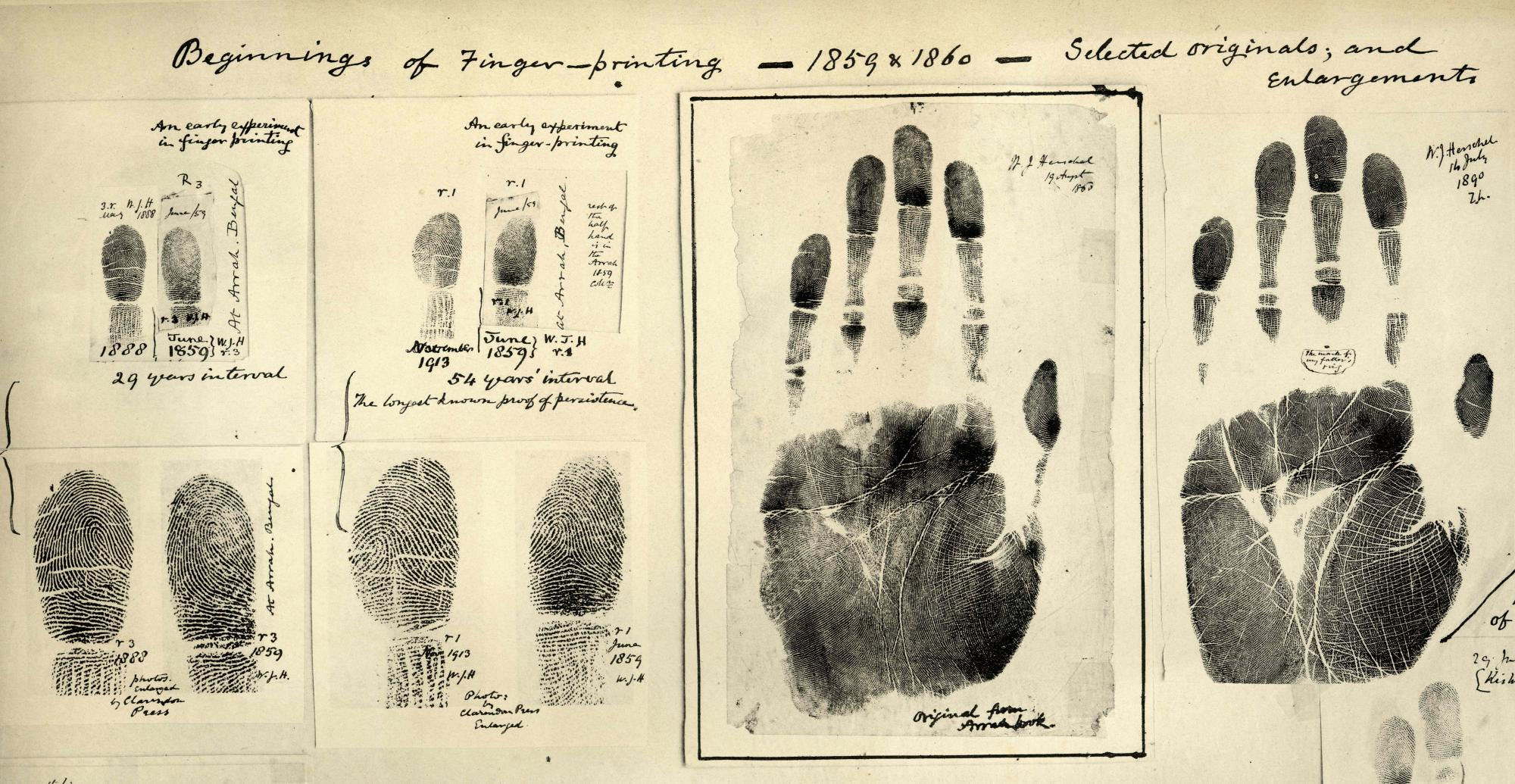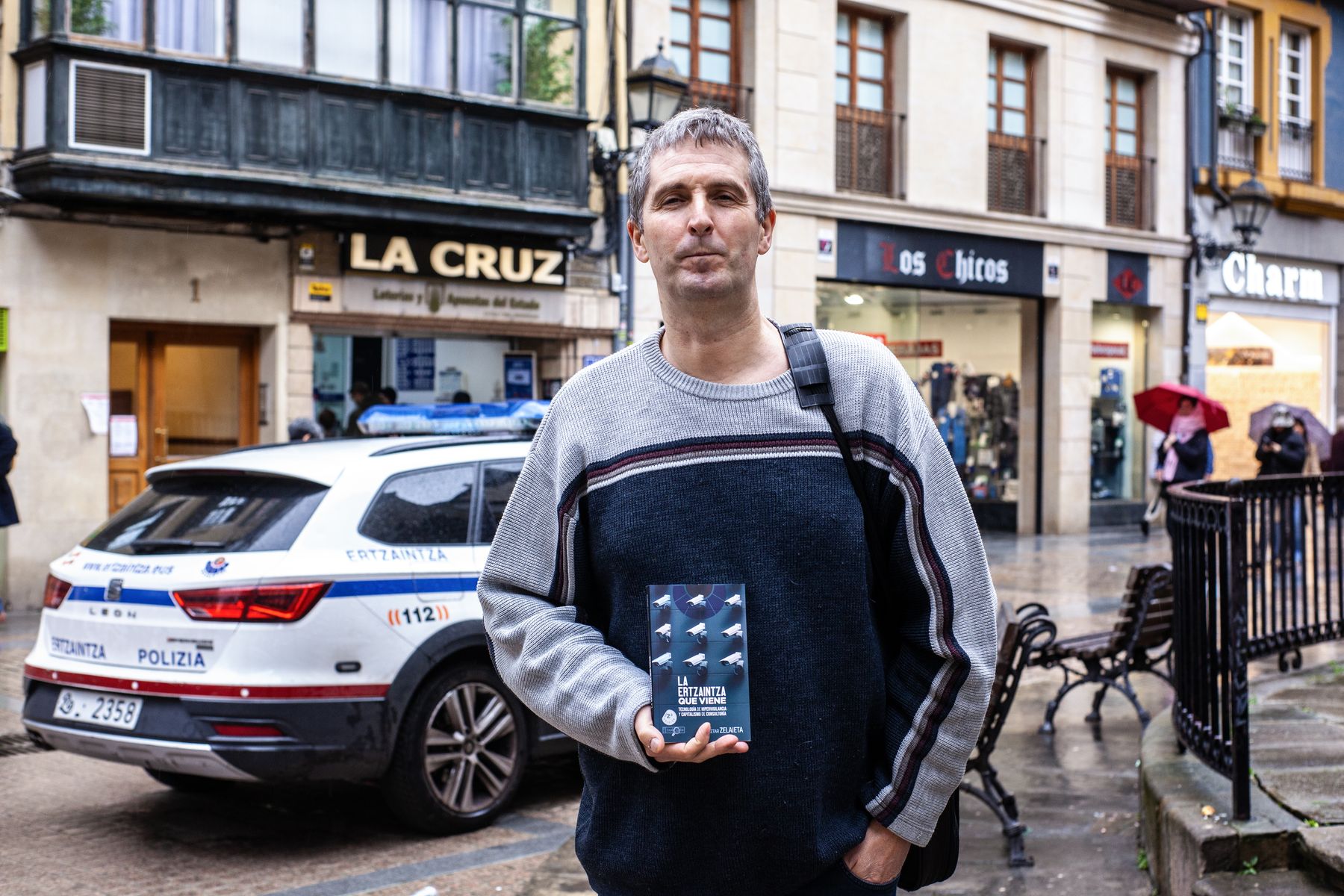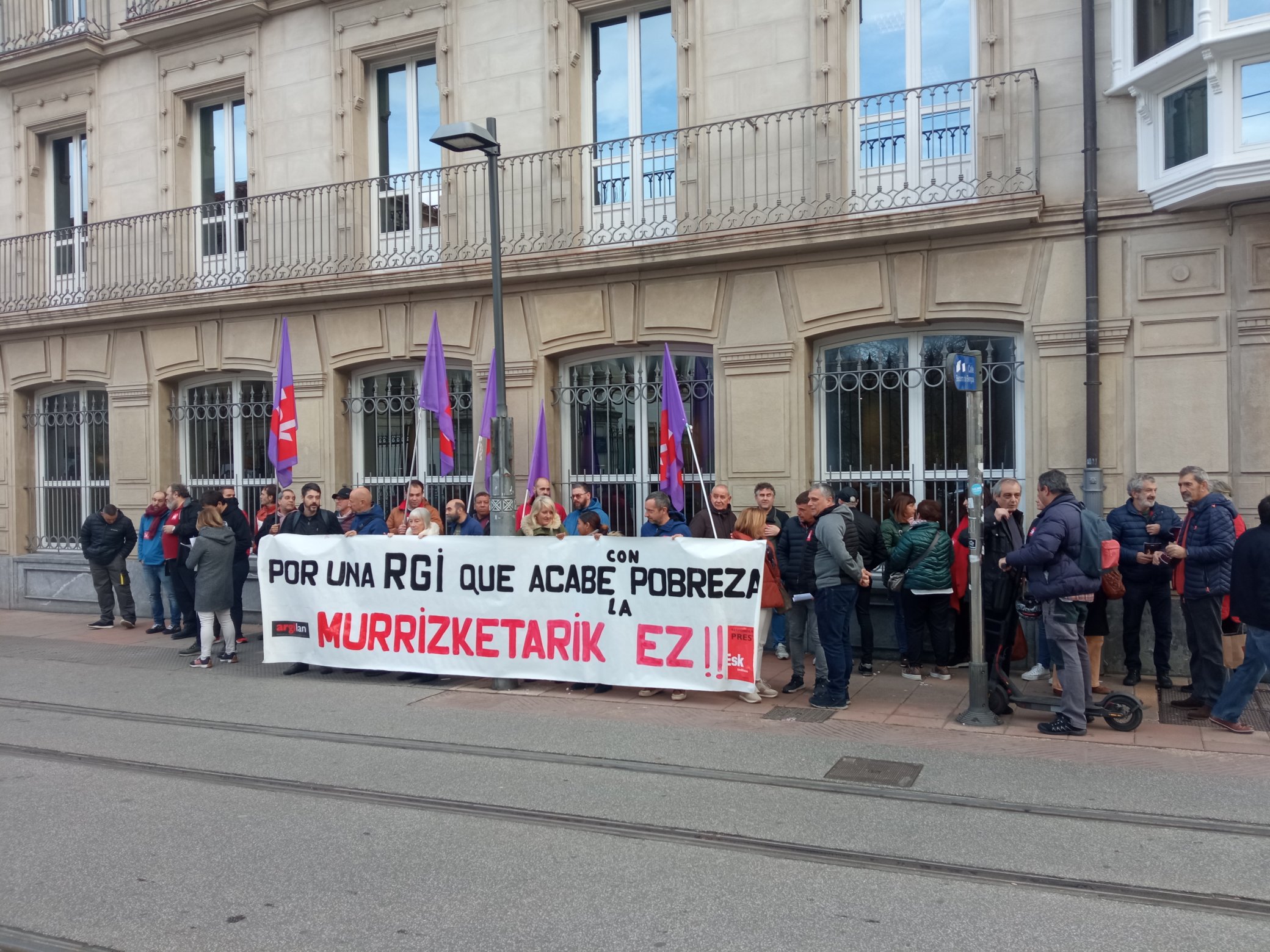[INNOCENTISM] Multiplication of opposition to public posts for the "mass demobilization" of the left and independence with the secret "weapon" of the authorities
- ARGIA has obtained information about a secret plan of the political and economic elites of Hego Euskal Herria. The Preventive Peace Plan report: public policies for post-conflict and post-well-being. In 2011 there was great concern among the leaders of Hego Euskal Herria. The disappearance of ETA could have led to independence, and the economic crisis would have created social confrontation: “A governance crisis may arise.” To avoid this, the main power groups reached an agreement aimed at ensuring social peace. The basis was to multiply the number and frequency of contests to the OPE to “demobilize progressive and Basque sectors”, among others. The plan has been in force since 2013.

The period 2008-2011 was of great economic and sociopolitical significance in the Basque Country. In 2008, the “economic crisis” erupted and states responded with cutting policies, definitively burying the paradigm of the welfare state in the West. In 2011 ETA made public its decision to abandon the armed activity. It was the end of a long process. Months earlier, the decision was ‘awarded’ by the public with spectacular electoral results to EH Bildu, including the government of the Provincial Council of Gipuzkoa. That same year, the M15 mobilising fire brought to light the political temperature of the Spanish State. The alarm was raised among the political and economic elites: the sum of these factors could generate a cocktail that questioned territoriality and the economic-political model. A ghost ran through the offices and administrative councils of the top leaders of Hego Euskal Herria: the ghosts of ungovernability. The need to do something to neutralize this risk became a topic of regular dialogue in the informal circles of political and economic elites in 2011.
Leadership of the PNV and Iñigo Urkullu
The PNV was the agent that formally shaped this need. The party formed a working group to analyse the situation and make a proposal for a response to it. It met for the first time on 12 September 2011. On the one hand there was the “Standing Group”, the core of the project. On the other hand, the main function of exchange of contrasts and views was the " Broad Group " , which met less frequently. The pace of work was very intense. For eight months, the working group closed a large 286 page report proposing concrete measures. ARGIA has obtained this report, which has so far been kept secret. He has also been able to collect the testimony of ‘Kosme’: From the beginning, Kosm became aware of the project and was part of the Broad Group of this working group, whose name is false. By stating that ARGIA has identified the project as an integral part of it, it has been willing to provide information on the condition of maintaining anonymity.
“It was a widespread concern, but no one put concrete action on the table. Then came the Catalan ‘helicopter’ and in Sabin Etxea there was no alarm, but panic”
Why did the PNV assume the leadership of the initiative? Kosm clarifies this: “It was a widespread concern, but no one put concrete action on the table. Then came the Catalan ‘helicopter’ and in Sabin Etxea there was no alarm, but panic”. In May 2011, the Catalan countries opened their own 15M: occupied plazas, general and sectoral strikes, incidents and mass mobilizations... The main jopunta were the extreme cutback policies of the government of Artur Mas, led by CIU. On June 15, 2011, an investiture session took place in the Parlament of Catalonia. The main point was the adoption of a package of raw cuts. Thousands of demonstrators surrounded the Basque Parliament to block it and make the dispute impossible. There were clashes between politicians and protesters who tried to enter Parliament from the ground. To avoid this, Artur Mas and other politicians came to Parliament by helicopter, which many understood as ‘humiliation’. From then on, 15Ma and the independence process came together and joined at one level. An era of uncertainties which, among other things, would lead to the disappearance of the CIU and the loss of the presidency of Artur Mas. According to Kosme, Iñigo Urkullu was the first to take action on the facts and the group that created his personal impulse was as follows: “It was still the lehendakari ‘Patxilo’ [Socialist Patxi López], but Urkullu was already clear that he would be next and swore to himself that he would never arrive by helicopter in the Parliament of Vitoria. That the PSOE-PP did it wrong, but well, that the streets and radicals wouldn’t throw it and the PNV of the presidency and the government.”
Estefanía Beltrán de Heredia and Jonan Fernández in the Lemoiz Central
With the approval of EBB, it was Urkullu himself who personally decided on the composition and functioning of the working group. Estefanía Beltrán de Heredia and Jonan Fernández were the first two people to join the project. According to Kosme, “EBB had already decided that, by ‘recovering’ the Basque Government, Estefanía would be the head of the Department of Interior and Jonan the general secretary of Rights, Coexistence and Cooperation. They had given their deserved. For Iñigo, it was important for a peace plan to combine the views of the ‘palo’ and the ‘carrot’. Jonan raised some doubts with Iñigo about the possibility of accumulating work on reaching the Basque Government, as there will be much to do in the area of prisoners and fleeing or coexistence. But Iñigo understood that, after explaining the PNV’s plans for these areas, he would have too much time.” The Standing Group (IT) consisted of Beltrán de Heredia, Urkullu and Fernández.
.jpg)
The IT took drastic steps to keep the project secret. The minutes of the meetings were taken manually, the following appointment was specified at each meeting and there was no contact between the members by telephone or internet. To ensure that no one would spy on or record their meetings, including the Spanish secret services, they were for a long time looking for a suitable place to meet. According to Kosme, it was located in reactor 2 of the Lemoiz nuclear power plant. “It was a proposal by Josu Jon Imaz, with which Urkullu shared his concerns from the outset. Through his contacts, he acquired the keys of the main entrance and of the reactor 2. The reactor walls have several meters of concrete thickness, it is not possible to receive any external signal.” ARGIA has not been able to confirm this last information.
With the approval of EBB, it was Urkullu himself who personally decided on the composition and functioning of the working group. Estefanía Beltrán de Heredia and Jonan Fernández were the first two people to join the project.
However, the IT wanted to combine secrecy with consensus. If it was a question of proposing concrete measures, it would be essential to approve all the points of power and to cooperate among them. That is why it was decided to form a Broad Group (TC). Between October and November 2011, IT participants made personal contacts. The project was very well received and on 30 November the CT was formally completed with its first meeting. In these meetings a broad representation of the CAPV's power spaces was gathered: businessmen, bankers, journalists, cooks, politicians, athletes...
The role of the CT was to give its opinion and approval to the proposals made by the IT. But it was the CT itself that made some proposal to the IT. In particular, the extension of the project to Navarra was a contribution of the CT: “It was clear to all of us that, beyond the differences with the national perspective, it was essential to work on the territoriality of Hegoalde in this matter.”
About four thanks to Volkswagen and Opus Dei
It was not easy to join the Nafarroa initiative. “Both UPN and the Diario de Navarra (DN) said they did not trust, that it was a small number of nationalists for the Basque Country to annexate Navarre and that they knew how to put an end to the problems of governance in their territory.” According to Kosme, CT contacts unlocked the situation: “A high command of Mercedes de Vitoria met with another of Volkswagen de Pamplona and a high office of the church of Gipuzkoa with another of the Opus Dei of Navarra. Both found that the interest was common, so it was agreed to put pressure on the citizens in the territory of Navarra. Volkswagen told UPN that if it did not join the initiative, it would transfer the Pamplona plant to the Alavesa Plain, and that Opusa would cut subsidies to the DN and put its University in Arantzazu. They accepted participation.” Representatives from UPN, PSN, Opus, DN, UGT and Volkswagen joined the CT. Two months later, to ensure trust and understanding, Jaime Ignacio del Burg joined the IT, formed by Urkullu, Fernández and Beltrán de Heredia, on the proposal of the Navarros agents unanimously. The place of IT meetings alternated then: one in Lemoiz and another in the Bardenas military polygon, in a shelter against air strikes. It was January 2012. From there, the project got speed. Inhaler technique was collected weekly and TC was collected once a month.
From the American housing model to the Basque labor opposition model
The first work that IT members received was documented. “In an era of profound and rapid changes, we wanted to know the situation, trends, concerns and intentions of society in general and of the Basque, leftist and militant sectors in particular,” points out in the introduction “Preventive plan of pacification: post-conflict and post-public policies for the welfare state” on page 12. “The sample has been very broad: analysis of the liquid society, Arnaldo Otegi’s speeches, evolution of the letters of the Su ta Gar or Izaro group, public writings of various popular movements and internal communications.” But it was a report by the U.S. Defense Ministry that lit the light to develop what was later the focus of the Preventive Peacemaking Plan.
“Gardener for Social Control” in USA I. It is a policy of social control developed after the World War. The Preventive Pacification Plan for Hego Euskal Herria is based on that.
The 1927 Gardener for Social Control Study was conducted by the U.S. Government. It analyzes the housing policy promoted in the post-World War period. The IT report summarises the research. I. During and after the World War, the United States came from all over the world to hundreds of thousands of communist and anarchist militants fleeing Nazism, war and hunger. The Government was afraid that these people would be organized and that the social war would be brought to the United States. The Government increased classical forms of control and repression against these sectors, but at the same time launched another strategy: the mass construction of large homes with private garden for the working class (“big house, transparent private”). These urbanizations, today so well known about the films, are made up of plots with a perishable wood structure of two floors and a private garden. The idea was that the tasks of maintenance and beautification of housing and, above all, of the garden would require a lot of time for the workers. The strategy was launched in 1918 in a few states with ‘greater subversive risk’. After the good results, in 1923 the project spread throughout the country. The 1927 report takes a more optimistic view: “It has been shown that the apolitical imposition of time-consuming apolitical activities is an effective means of guaranteeing social peace. The policy 'Gardening for social control' has had an undeniable success, and opens up a whole field of possibilities for the future. The ‘Gardening for Social Control’ policy has been successful and opens up many possibilities for the future”).
Point 2 of the Pacification Plan, “Lines of Research”, raises the question that the work of the US Defense Ministry raised in the IT: “The housing bubble swelling is not real in the CAPV and in Navarra, but: What can be the ‘apolitical action that can be imposed in an apolitical way and that will take a long time in our territory?’” After brainstorming and IAAA dynamics (Strengths, Weaknesses, Risks, Opportunities), one of the proposals took center stage: “Permanent Preparation of Labour Competitions” (Oppositions for Social Control).
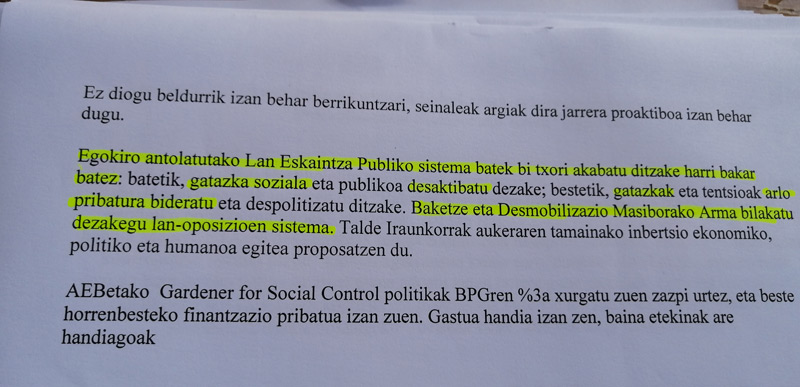
Public Job Vacancies: “Weapon for Mass Pacification”
Before taking further steps, the IT commissioned Aztiker Soziologia Ikergunea an investigation to measure the impact that the preparation of work oppositions has on the life of a worker. The results were more clarifying than expected. The Peace Plan report that ARGIA has received does not include the full study, but the most relevant data.
Aztiker conducted quantitative interviews with 213 people who presented to one or more competitions between 2010 and 2012. On average, each opponent studied for 7.3 months. During this time, the unemployed spent 7.5 hours in the study, while the unemployed did 4.2 hours. Aztiker researchers asked opponents about the impact the preparation of the opposition had on each person's life. To the question “Has the preparation of the opposition increased the conflicts or tensions in your closest environment?”, 22% of respondents answered “yes, much”, 43% “yes, significantly”. In the case of members of families with children, the “yes, much” response increased to 44%. "Before starting to prepare the study, did you dedicate time to initiatives or socio-political groups of a transformative nature? the respondents were asked. A second question, for those who settled, was: “Have the preparations of the opposition to their social commitment taken time off?” 46% of the opponents answered “yes, a lot”, compared to 20% who answered “yes, clearly”. Aztiker’s investigation dates from April 2012.
The Aztiker Center for Sociological Studies conducted a study in 2012: “Have the preparations of the opposition to their social commitment taken time off?” 46% of the opponents answered “yes, a lot”, compared to 20% who answered “yes, clearly”.
The study also outperformed the most optimistic intuitions of IT. “When they presented us with an investigation and a proposal on this in the Broad Group, they looked like children. Imagine, Urkullu smiled. Jonan constantly repeated ‘without haste, the important thing is consensus and coexistence’, but he could not conceal joy. Jaime responded with a careless response that with this degree of consensus he would also accept a ‘Permanent Common Organ’ between Navarre and the Basque Country. Estefanía assured that she wasn’t going to fail, but if she did, we would always have the stick by hand,” Kosm says. The report of the Peace Plan clearly reflects this optimism: “A well-organized Public Employment Supply system can wipe out two birds in one stone: on the one hand, it can deactivate social and public conflict; on the other hand, it can direct and depoliticize conflicts and tensions to the private sphere. We can turn the system of labor oppositions into a Weapon of Pacification and Mass Demobilization. The Standing Group proposes an economic, political and human investment to the size of the option.” The CT unanimously approved the project in May 2012 and mandated IT to start developing since 2013. The plan was then under the responsibility of more technical people, always under the supervision of the IT and the CT.
Multiplying calls, reducing jobs
The Pacification Plan details the proposal in paragraph 3: “Multiplying calls and examiners, reducing public jobs,” is entitled. On page 187, the report summarises the “Strategy for the Five-Year Period 2013-2018”: “The intention is twofold: on the one hand, the Basque public administration will multiply the number of calls for Public Employment Offers and, on the other, balance those jobs generated with cuts and set-aside, ensuring a gradual drop in the total, in line with the fiscal balance policies implemented by the European Union. The challenge is to quadruple by 2018 the ratio of opponents to each job.”
In order to achieve the objectives, the report proposes, among other things, “multiplying economic and political investment” to advertise each of the Public Job Vacancies, through the public and private media. “It is necessary to make the public think that the number of public jobs is increasing and that they have a great chance of becoming civil servants.” The offerings had to be “divided and arranged in time” at the same time. For example, if in two years the offer of 300 places in Education is expected to be expanded, “the ideal” would be to hold four calls for 75 positions. In this way, “we will integrate the preparation of oppositions in the landscape of everyday life”.
The report details a number of strategic frameworks for the implementation of the Plan: Education, Fire, Police, Public Administration and Osakidetza. Among them, the Peace Plan proposes prioritizing Education and Firefighters, “to whom the Basque, leftist and anti-systems sectors are presented in greater proportion”.
.jpg)
Data pacification plan
Beyond the intentions, can we see any change in the policy of Job Vacancies? Was the secret plan developed? The comparison of data between the National Institute of Statistics (INE), Gaindegia, the Basque Institute of Statistics (Eustat) and the Navarro Institute of Statistics (Nastat) shows clarifying results for the peninsular Basque Country.

.jpg)
In the period 2013-2018, the number of officials of the CAV and Navarra administrations has decreased by 9.8%. By contrast, the number of calls for Public Job Vacancies has increased by 183%. The Peace Plan prioritized both Education and Firefighters, an increase of 293%.

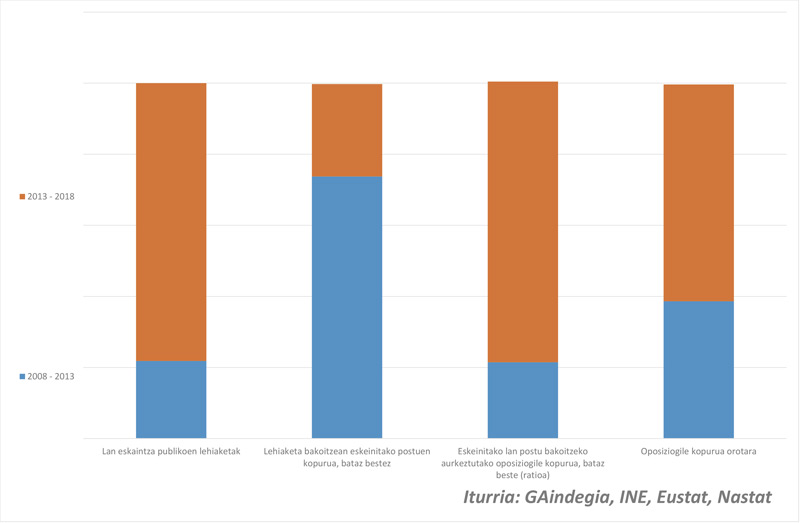
Compared to the period 2008-2013 of 2013-2018, the number of competitions for OPE has increased by almost four (by 3.72). In the period 2008-2013, an average of 132 places per call were offered, compared to 47 in 2013-2018. In the 2008-2013 five-year period there were 114 opponents per job; between 2013 and 2018, the ratio has risen to 417 people per job. Between 2008 and 2013, 267,342 citizens were presented to some opposition; between 2013 and 2018, 424,321 (of which 296,982 have been presented to two competitions). And there are 154,387 citizens who have registered in “three or more oppositions”.
The social conflict downwards
What development has the conflict and social mobilization had during the five-year period of the Peace Plan? Has it gone up or down as the number of opponents multiplied? Data from the Interior Departments of the CAPV and Navarra show a significant decrease in the main variables:

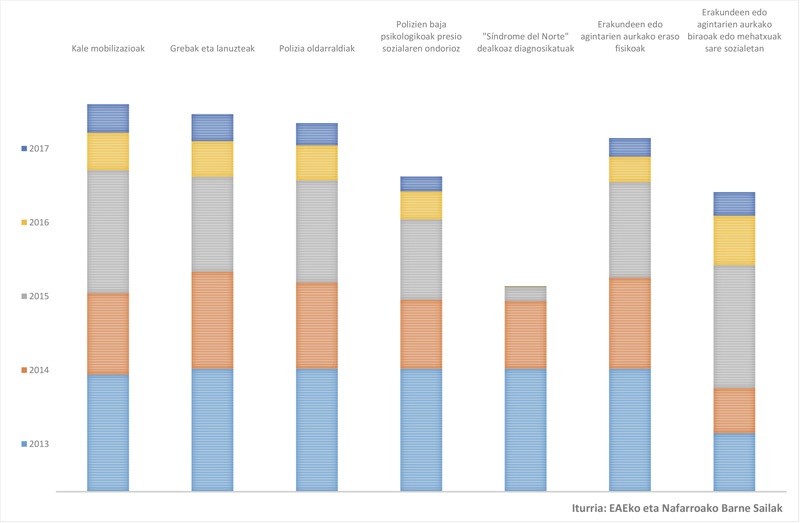
The downward trend is general and affects all variables. The only exception is 2015. Most of the indexes increased that year, probably due to the splashes caused by the mobilizing wave of 15M in Spain in the Basque Country, but for next year the descent continues. Mobilisation declined by 52% between 2013 and 2017, strikes and arrests by 59% and physical attacks on institutions and authorities by 67%. Citizens only on 35 occasions gave reasons to the police to launch them, 72% less than in 2013. Virtual irritation is still fashionable, but there have also been cutbacks in that: 53%.
Can these trends be attributed to the policies of the Peace Plan? It's hard to say, but there are elements that make you think it's influenced. In 2015, the Joxemi Zumalabe Foundation carried out a process of reflection on the new models of militancy with the participation of dozens of popular movements. “Is there broth? In April 2017, the document “People’s Movement, Bulbo, Salinillas or Encuradas?” takes up the conclusions of the process and in the section “Adaptation to New Paradigms” reads: “Two are the novel elements that affect the ways of understanding the militancy and the life and capabilities of the collectives: cybermilitancy and the opposition. Popular movements point out that the phrase ‘I’m not going to be able to engage this course very much because I have to prepare the opposition’ is becoming an expression in their meetings.” In an internal Sortu newsletter of November 2016 you can read: “The debate on the working conditions of our liberates must be held. Our political project has difficulties for continuity due to the gap between the liberates: many liberated prepare the oppositions in secret and if they get a job they leave the structure from day to day, without transmission”. In the January 2018 issue of the libertarian journal Acción Directa, the article “Reviving the institutions from the inside” said: “Criticisms of colleagues who have moved to the trench of struggle of the public administration are childish and comfort us in the lack of effectiveness in the name of a supposed purity. Let us not be fooled: we can influence anarchism more by doing ideological work on the Basque Government coffee machine than by publishing ‘totxs’ magazines for our self-consumption.”
Fraud in Osakidetza to reward entrepreneurs?
The Peace Plan did not limit the objective of demobilization to the stage of the preparation of public competitions. The report proposes identifying potentially problematic potential examiners of governance and raising the note fraudulently, functioning: “After decades of illegalization and repression, the administration has many useful data from thousands of entrepreneurs. We propose the creation of a Hazard Index by crossing various variables (criminal background, opinions on networks, militancy area...). The note by the anti-system opponent would be increased in proportion to the danger represented by that index. It is not a question of introducing all antisystems into administration, it can be dangerous, but of confusing them in the right proportion to neutralise the potential risk of some people. From the watchtower of operation you see ideologically equal or more injustices, but feel and live quieter”.
ARGIA cannot guarantee that this selective fraud has been committed. We have no evidence. Kosm says it has been done. What’s more, he says that’s what’s behind the Osakidetza OPE fraud: “It doesn’t come out because it’s in nobody’s interest. Those who prepared the test are said to have passed the tests on to their ‘friends’. That would also happen, but the tests also leaked to the workers who generated the most conflicts in the workplace, and that I know the assessment is positive.” According to Kosm, the same as in Osakidetza has been done in Education, Fire or in the administration points of the municipalities. In an instant, the plans were lost: “To break the long strikes in nursing homes, it was thought to create a few positions of officials and call for competitions. But right then it was decided to dissolve the Pacification Group, and the idea was halfway.”
"Popular movements state that the phrase ‘this course I will not be able to make a great commitment to having to prepare the opposition’ is becoming an expression in their meetings” Joxemi Zumalabe
Vans, therapies, mountain races...
The Pacification Plan proposes to develop further lines of secondary intervention. A subsidy policy for the purchase of vans for young people under the age of 45 “so that activists can link to credits and travel outside their work, and not participate in demonstrations”; mass public private promotion campaign of therapies of all kinds (art, risotherapy, dance, psychotherapy...), “For everyone to focus on their things”; to create the Basque Professional Circuit of Mountain Racing “to channel the anxiety for lack of adrenaline in times of conflict on a peaceful path”.
According to Kosme, these lines did not develop. For two main reasons: “First, it was seen that the leftist and Basque sectors resorted to them massively, without the need for any impetus. Secondly, we were already clear that the Preventive Peacemaking Plan was not necessary.”
Dissolution of the Pacification Group
The Pacification Group was dissolved at the end of 2017. The members of the team felt that the fears and concerns that led to the event had been exaggerated. “The fear then seems absurd today. But who would tell us that in 2012 a cycle of exemplary social peace would be opened in the Basque Country. Half a world in flames, the dismantling of the welfare state, the revolt of the Catalan countries... And between us, completely quiet. If it wasn't for feminists, perfect peace. Too boring and I would say everything, Teleberri has lost all interest,” says Kosm.
Kosm recalls the humility of the Permanent Group: “At the last meeting, Urkullu spoke on behalf of all. He stressed that the work carried out was exemplary, but that the main merit had to be recognized by the left and the independentists. We read the poem “A Way to Look at the World” by Kirmen Uribe, and with a toast we officially dismantled the group. It was moving. Then we organized it in Lemoiz Reactor 2, and the rave, on the contrary, wild!” It was December 28, 2017, a noted day. The Pacification Group disappeared, but as it was already organised and in progress and the results were assessed positively, it was agreed to maintain in force the new system of public job vacancies. The Peace Plan went, but the policy of Oppositions for Social Control remains in place.
Europar Batasunean berriki onartu den Migrazio Itunak, asko zaildu dizkie gauzak euren herrialdetik ihesi doazen eta asiloa eskatzen duten pertsonei. Eskuin muturraren tesiak ogi tartean irentsita, migratzaileentzako kontrol neurri zorrotzagoak onartu dituzte Estrasburgon,... [+]
In the Basque Parliament, the legislative amendment to the Basque System for Inclusion and Income Guarantee has advanced. We need to look at the debate on the law, the agreements on the left and the right to amend it, and at the limited impact that the reforms brought about by... [+]
Video surveillance is not something new on our streets, neither in San Sebastian, nor in Euskal Herria, but what is especially serious is that the increase in smart video surveillance, which implies increased security and social control, is taking place without any kind of... [+]








